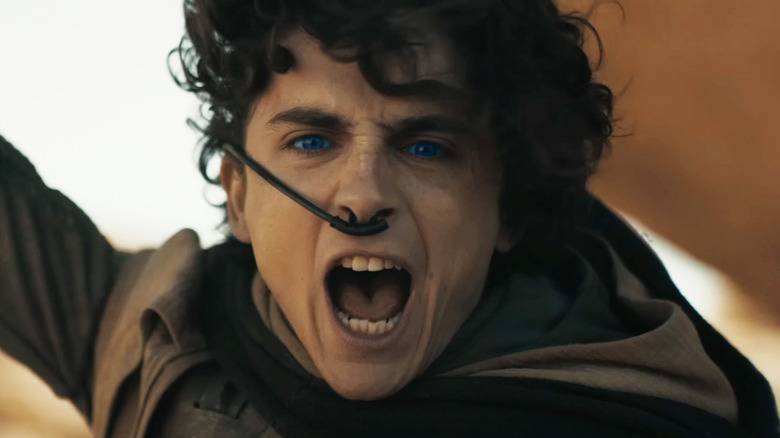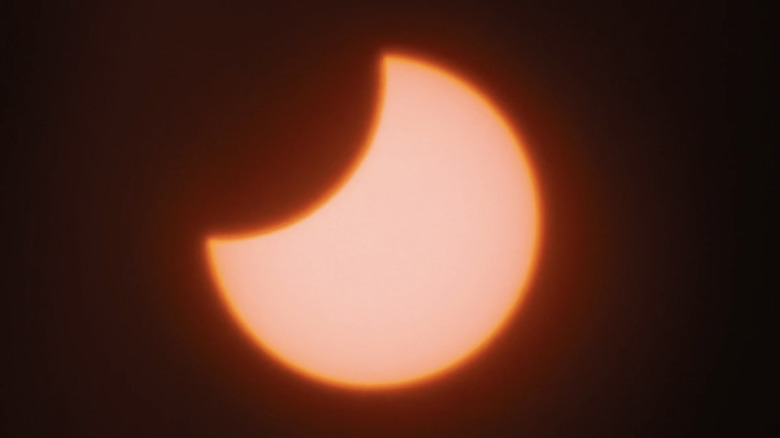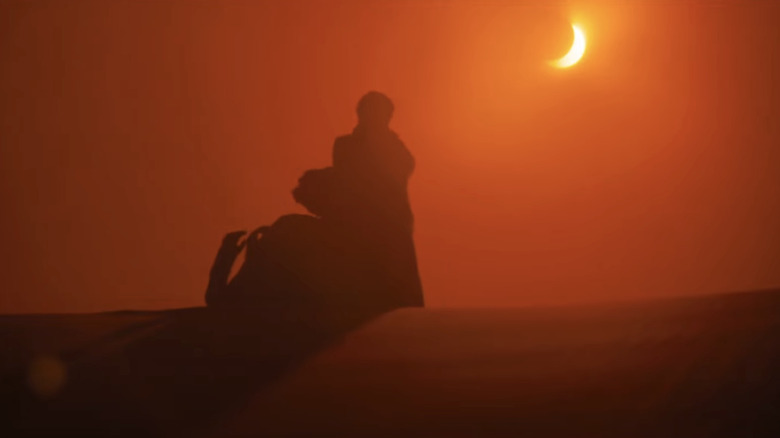Dune 2 Actually Captured A Real Eclipse In The Jordanian Desert
We may receive a commission on purchases made from links.
"Dune: Part Two" may have been a bit of a bleak blockbuster, but compared to its predecessor, 2021's "Dune," it's positively refulgent. While the first movie spent a lot of time on exposition and establishing the rules of Denis Villeneuve's interpretation of Frank Herbert's 1965 novel, "Part Two" signals that it's a much more action-packed and visually diverse affair right from the off.
As the film opens, we join a team of Harkonnen hunters on the barren plains of the planet Arrakis. The group are hunting Fremen, the native inhabitants of the desert planet who have recently been joined by Timothée Chalamet's Paul Atreides and Rebecca Ferguson's Lady Jessica. After we witness the villainous cohort evade a potential sandworm attack by way of their anti-gravity packs — a peak sci-fi moment for cinematographer Greig Fraser — they suddenly come under attack by Atreides and his new allies. As the fight goes on, a vivid shot of the sky overlooking the scene reveals everything is unfolding beneath a solar eclipse, which is what gives the entire sequence its otherworldly carmine glow.
2021's "Dune" had a very homogenous look, simply by virtue of the fact that most of the story unfolded within the confines of the Atreides stronghold in Arrakeen. But "Part Two" switches things up almost immediately with its battle set against an eclipse, and later with the use of infrared to shoot exclusively in monochrome for the exterior scenes on the planet Giedi Prime. But what makes the eclipse battle all the more impressive is the fact that Villeneuve and Fraser actually managed to capture the astronomical event for real.
Capturing a real eclipse for Dune: Part Two
In the book "The Art and Soul of Dune: Part Two," from authors Tanya Lapointe and Stefanie Broos, Greig Fraser explains much of what went into capturing the opening battle scenes. According to the cinematographer, an Infrared cut filter was used to remove some blue and green from the color spectrum and "lean more into the red wavelength." But it seems the biggest helping hand Fraser and the crew got came not from camera additions or VFX, but nature itself.
As the DP went on to explain, neither he nor any of the team had planned to capture a real eclipse on film, but while on-location in Jordan, that's exactly what transpired. The event, which took place on October 25, 2022, lasted for around two hours and 25 minutes, and saw 35% of the sun obscured by the moon. This allowed Fraser and his camera operators to shoot directly into the sun and capture the eclipse in real-time. One of these shots is featured early in the opening battle in "Dune: Part Two," and acts as a way of motivating the change from the regular daytime light to a more red-tinged hue.
Not only was the shot of the real eclipse used during the battle, a wider shot was also used earlier in the movie during the initial opening sequence. In this version of the shot, visual effects supervisor Paul Lambert and his team used CGI to create a second moon, which was then added to the eclipse footage to give the appearance of Arrakis' double lunar bodies gliding around the sun.
Dune and Dune: Part Two were meticulously planned out
Every aspect of the "Dune" and "Dune: Part Two" was finely crafted, with Denis Villeneuve, Greig Fraser, and production designer Patrice Vermette trekking through the deserts of Abu Dhabi and Jordan in search of the perfect sand dunes to use in the movie. Ultimately, Villeneuve claimed that he and his team ended up "sand traumatized" from this fastidiousness, but it clearly made for a visually stunning result. Meanwhile Vermette drew from a dizzying array of inspirations to craft the visual language of Arrakis and Geidi Prime, referencing everything from Rolex watches to, believe it or not, a field full of septic tanks, which inspired part of Dune's landscapes.
For his part, Fraser went to great lengths to plan out the shots used in the film in minute detail. As noted in "The Art and Soul of Dune: Part Two," the cinematographer used "3D Unreal Engine software, photogrammetry, drones, and ground lidar scanning" to pinpoint the precise time of day when each shot should be filmed. A good example of this comes during the opening battle beneath the eclipse in "Part Two," wherein Fraser "identified the precise time, date, and location" where he could recreate a shot from the storyboards of Lady Jessica killing a Harkonnen soldier with the sun directly behind her.
Meanwhile, Villeneuve also told the authors that he shot the entirety of "Part Two" in IMAX, which must have come in handy when capturing the eclipse in all its impromptu glory. While so much of the film was meticulously planned out, then, it's nice to hear there was some spontaneity to the eclipse shots. Frankly, it's also slightly unbelievable that the cinematographer was tracking lighting conditions so closely and had no idea a solar eclipse was on the cards.


